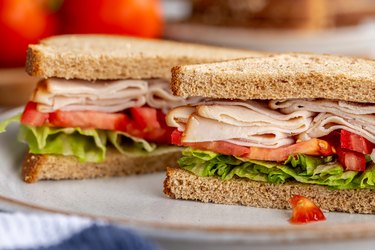
There used to be a hard-and-fast limit on recommended dietary cholesterol intake: no more than 300 milligrams per day. (So long, mile-high Reuben-on-a-roll and other high-fat lunch meat favorites!) But current "Dietary Guidelines for Americans" no longer restrict the amount of cholesterol you consume.
So how do you know which lunch meats you can enjoy without too much guilt? According to an American Heart Association advisory published in January 2020 in the journal Circulation, "recommended eating patterns will naturally contribute to low amounts of dietary cholesterol because dietary cholesterol commonly coexists with major food sources of saturated fat."
Video of the Day
Video of the Day
Why the Change
There's less focus on cholesterol restrictions because "what really matters is the type of fat in your diet," says Julia Zumpano, RD, LD, a registered clinical dietitian in the Department of Nutrition Therapy at the Cleveland Clinic in Ohio.
The American College of Cardiology explains that the country's dietary guidelines are updated every five years to reflect what the latest research says about a healthy diet.
The current guidelines, which span 2015 to 2020, set limits on saturated fat, which involves the bad type of cholesterol that leads to heart disease, but no limits on total cholesterol, which includes both good and bad cholesterol. Saturated fat, though, is limited to 10 percent of your daily calories. If you follow the diet recommended by the current guidelines, you should be getting about 100 to 300 milligrams of cholesterol.
"Saturated fat is fat from animal proteins," Zumpano says. "Saturated fat is solid at room temperature and raises your bad cholesterol. Unsaturated fat comes from vegetables, stays liquid, raises good cholesterol and is good for heart health." She adds, though, that two vegetable oils do have saturated fats: palm oil and coconut oil, "and you want to avoid these."
Healthy Lunch Meats
Though people sometimes think of lunch meats as an unhealthy no-no, you can in fact have a healthy sandwich if you stick to lunch meats that are low in saturated fat and salt. Zumpano suggests these healthy choices: lean chicken, turkey or roast beef; baked ham; oven-roasted meats; and low-sodium meats — all on whole-grain bread.
According to the American Heart Association (AHA), chicken, fish and vegetable proteins like beans are better for you than red meats (like beef, pork and lamb). When thinking about a healthy meat sandwich, the AHA offers such tips as controlling portion size (2 to 3 ounces or "about the size of a deck of cards"), selecting lean cuts, trimming off the fat and avoiding processed varieties (think bacon, salami, hot dogs, deli slices and the like).
Processed lunch meats are not just bad for heart health, but they may also increase your risk for cancer, according to June 2020 American Cancer Society guidelines published in CA: A Cancer Journal for Clinicians. Colon cancer, in particular, is a concern if your diet includes processed meats and high amounts of red meat, according to the American Institute for Cancer Research.
What qualifies as processed meats, notes the University of Rochester Medical Center, are any kind of meat (red or white) that has been salted, cured, fermented or smoked (or taken through any kind of process) to preserve or enhance the flavor of the meat, which includes the likes of deli meats (aka lunch meats), ham, hot dogs, bacon, sausage and more.
What to Eat
Current guidelines target three food elements for reduction — saturated fat, sodium and added sugars — explains the American College of Cardiology, and recommend a healthy eating pattern as one that's high in vegetables, fruit, whole grains, seafood, legumes and nuts, includes a moderate amount of low- and nonfat dairy products and a low amount of red and processed meat, sugar-sweetened foods, and beverages and refined grains.
And if the volume of dietary information seems overwhelming, cut to the chase with some recommendations from the experts.
- For breakfast "If you don't have high cholesterol, you can have eggs for breakfast (up to six eggs a week)," says Zumpano. "Other good breakfast foods include whole grains, nonfat yogurt and fresh fruit." The AHA suggests replacing bacon or sausage with low-sodium, nitrate-free turkey bacon to go with a vegetable omelet.
- For lunch:
Slice up some leftover turkey or chicken, choosing whole-grain breads and even swapping mayo for ripe avocado, suggests the AHA.
- For dinner:
he AHA suggests such healthful options as grilled chicken without the skin or baked fish; a salad with beans, fish or chicken; or black or garbanzo bean burgers.
The bottom line, according to AHA and the American College of Cardiology, is that if you stick to healthy diet choices, you will reduce your risk for high cholesterol. Don't worry about the cholesterol numbers associated with the foods you eat — just choose the right foods.
- Office of Disease Prevention and Health Promotion: “Dietary Guidelines for Americans, 2015-2020”
- Julia Zumpano, RD, LD, registered clinical dietitian, Department of Nutrition Therapy, Cleveland Clinic, Ohio
- American College of Cardiology: “The Dietary Guidelines for Americans (2015-2020): Knowing the New Recommendations for Healthy Eating Patterns”
- American Heart Association: “Meat, Poultry and Fish: Picking Healthy Proteins”
- American Institute for Cancer Research: “Colorectal Cancer”
- University of Rochester Medical Center: “Lunch Break: Healthy Alternatives to Deli Meats”
- CA: A Cancer Journal for Clinicians: "American Cancer Society Guideline for Diet and Physical Activity for Cancer Prevention"
- Circulation: "Dietary Cholesterol and Cardiovascular Risk: A Science Advisory From the American Heart Association"
Is this an emergency? If you are experiencing serious medical symptoms, please see the National Library of Medicine’s list of signs you need emergency medical attention or call 911.